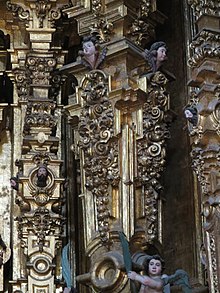|
Estipite  The estipite column is a type of pilaster used in buildings in the Mannerist and Baroque styles,[1]a moment when many classical architectural elements lost their simple shapes and became increasingly complex, offering a variety of forms and exuberant decoration.[2] This sort of column has the shape of an inverted pyramid or obelisk. Sometimes the shaft is wider in its middle part than in the base or capital.[3][4] There are many examples by architects like Michelangelo’s Biblioteca Laurenziana (1523-1571) and others.[5] It became later a signature element of the Churrigueresque Baroque style of Spain and Spanish America in the 18th century.[6] CharacteristicsFormThe shape of the estipite has a narrow base and the shaft is in the shape of an inverted obelisk.[7] This is a variation to previous uses of the pilaster which deviates from classical architecture with its form. In classical architecture, pilasters give the impression that they have a load bearing function. However, due to the obelisk shape of the estipite, this tradition is disrupted.[8] The estipite is not supposed to look solid, instead be dynamic and create movement. Creating an apparent lightness to the structure.[5] Manuel Toussaint defines estipites as: “A supporting member, square or rectangular in section, and formed of multiple elements: pyramids and truncated prisms, parallelepipeds, superimposed foliage, medallions, garlands, bouquets, festoons. The ornament is all vegetable, applied to geometric forms”.[5]  CapitalsThe capitals usually highlight the line of a broken cornice and are unabridged. Or may be connected to another estipite by a horizontal entablature.[9] The capital for esiplite pilasters are typically Corinthian.[7] There are deviations to this. For example, decorations of vegetation and cherub heads take the place of the Corinthian capital in Capilla del Sagrario for the Cathedral of Segovia by Jeronimo de Balbas.[5]  Double ColumnsSimilar to Baroque styling with the use of double columns, the double estipites is a feature in some Churrigueresque buildings.[9] Alongside other stylesEstipies were utilized between Ultra-Baroque and the rise of Neo-Classical styles. Therefore, even though estipites are distinct in style, they are sometimes used alongside Solomonic and classical columns. A good example of this is San Francisco Acatepec in Puebla.[7] HistoryOriginIn Richard W. Amero's thesis, The California Building: A Case Of The Misunderstood Baroque, he claims that Michelangelo is the first one to use an estipite pilaster in the Laurentian Library (1526).[9] Meanwhile, John F Moffitt states in his thesis El Sagrario Metropolitano, Wendel Dietterlin, and The Estipite that Juan de Arfe y Villafane could have been the first known person to mention the estipite. This is seen in Arfe's, Description de la traza de la custodia de la Iglesia de Sevilla (1587).[8] Therefore, the origins of the estipite are debated among scholars. Spain and New SpainThe architect known for making estipites popular is Jose Benito de Churriguera, who has the Churrigueresque style named after him. His first works with estipites were Capilla del Sagrario for the Segovia Cathedral (1690) and Convento de San Esteban, Salamanca (1693). Jeronimo de Balbas was a Spanish architect who moved to Mexico (New Spain) in 1717, and introduced the new world to estipites. His work Retablo de los Reyes in the Mexico City Metropolitan Cathedral (1718–37) was the first building to showcase estipites in the New World. The era of estipites only lasted till 1783 with the establishment of Academia de San Carlos, an architecture school in New Spain. However, in this short period of time 1736, the completion of Retablo de los Reyes, till 1783, many buildings in New Spain (Mexico) had facades or alters with estipites.[5] Due to the decline in popularity for the estipite pilasters, Solomonic and Classical columns were revived throughout Spain and New Spain. This led to many estipite-style monuments to be destroyed or replaced with classical columns in the last decades of the 1800s.[10]  BuildingsSmall list of buildings that estipites are a design feature for. References
Wikimedia Commons has media related to Estipite. Information related to Estipite |
